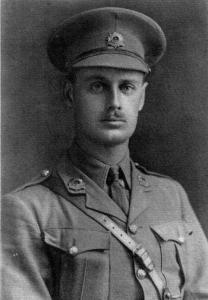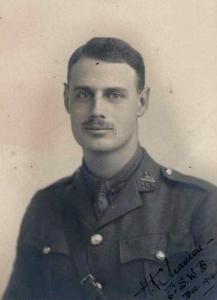
|

|
| Lieutenant Harold Ashcombe CHAMEN | |
|
B Company, 2nd Battalion Bedfordshire Regiment Date of birth: 2nd March 1894 Date of death: 1st August 1916 Died of wounds aged 22 Buried at Corbie Communal Cemetery Extension Plot 2 Row A Grave 22 |

|
| Harold Ashcombe Chamen was born at "Crowley", Baker Road, Harlesden in Middlesex on the 2nd of March 1894 the younger son of William Ashcombe Chamen, an electrical engineer (later General Manager of the South Wales Electrical Power Distribution Company), and Marion Mabel (nee Heisch) Chamen of 23 Victoria Square, Penarth in Glamorganshire. He was christened on the 1st of April 1894 at All Souls Church, Harlesden. He was educated at Wells House School, Malvern Wells in Worcestershire and at Lancing College where he was in Heads House from September 1908 to July 1911 and where he was in the Officer Training Corps for three years. He was appointed as a House Captain in 1910. On leaving school he went on to Aspatria Agricultural College in Cumberland and then to University College Reading as an Agricultural Scholar where he was a member of the Officer Training Corps. While he was at Reading he applied for a commission in the Special Reserve of Officers on the 6th of August 1914, in an application which was supported by Captain R.W. Pearson, in which he expressed a preference for the Dorset Regiment then the Gloucestershire Regiment and finally for the Somerset Light Infantry. He was commissioned as a 2nd Lieutenant in the Special Reserve on the 15th of August 1914 and, in spite of his preferences, was attached to the South Wales Borderers on the 21st of September 1914. He underwent a medical examination at the War Office in London on the 5th of September where it was recorded that he was five feet eleven inches tall and that he weighed 168lbs. He decided to make the army his career and trained at the Royal Military College at Sandhurst where he was in B Company, following which he was commissioned as a 2nd Lieutenant in the Bedfordshire Regiment on the 12th of May 1915. He embarked for France on the 8th of July 1915 where he joined the 2nd Battalion of his regiment in the field on the 21st of July and was posted to C Company. On the 31st of July he was returning from a front line trench in the dark when he stumbled and impaled his right thigh on a bayonet. His father received the following telegram dated the 3rd of August 1915: - "2nd Lieut. H.A. Chamen Bedford Regt. was wounded 31st July. Further news will be telegraphed when received." He was evacuated to the rear and was admitted to No. 2 General Hospital at Le Havre on the 4th of August. His father received a further telegram dated the 9th of August 1915: - "2/Lieut. H.A. Chamen Bedford Regt. admitted 2 General Hospital Havre 4th August with bayonet wound right thigh. Progress will be reported." He was evacuated to England from Le Havre on the 5th of August 1915 on board the troop ship “Oxfordshire” landing at Dublin on the 7th of August. His father received a telegram dated the 16th of August 1915: - "2 Lieut. H.A. Chamen Bedford Regt. admitted Officers Hospital 33 Upper Fitzwilliam Street, Dublin August 7th" On the 18th of August 1915 a Medical Board was convened at the Officers Hospital, Dublin to report on his case: - "In returning to his trench in the dark he fell against a bayonet which had been left leaning against the parapet. He received a penetrating wound on the outer side of the thigh at its middle. No important structures were involved and the wound is healing rapidly." He was granted leave from the 18th of August to the 17th of September 1915 On the 18th of September a Medical Board which sat at the Military Cardiff declared him fit for general service and he reported to the 4th (Reserve) Battalion of his regiment at Cholderton on the 21st of September 1915. On the 7th of February 1916 he was passed as fit for overseas service and rejoined his battalion in the field at Maricourt where he was attached to B Company. On the 12th of February he was attached to the 3rd Entrenching Battalion, rejoining the 2nd Battalion on the 4th of June 1916 at their billets at St. Sauveur. He was promoted to Lieutenant on the 25th of May 1916 which was antedated to the 30th of March 1916. He was left out of the attack on the opening day of the Battle of the Somme on the 1st of July 1916, but was appointed as Commanding Officer of B Company when the Company Commander, Captain Pearse, sprained an ankle on the 10th of July. At 5pm on the afternoon of the 10th of July 1916 the 2nd Battalion Bedfordshire Regiment received orders to attack enemy positions at Trones Wood the following morning and to dig in on the eastern side of the wood. These positions had been attacked previously on two occasions with both assaults ending in failure. At 11pm that night the battalion moved up the Brequeterie Road to a sunken road just to the east of Brequeterie where they were in position at 1.30am. Zero Hour was set at 3.10am and a Company was to lead the attack with B Company, under the command of Harold Chamen, following close behind them. At 3.10am the leading companies began their advance towards the south eastern end of the wood. Due to the darkness the leading waves were not spotted by the Germans until they were four hundred yards from the wood. At that moment they came under heavy machine gun and artillery fire and began suffering heavy casualties. In spite of the heavy fire they began to enter the wood by 3.45am where the dense undergrowth prevented forward vision. The enemy proved to be well dug in to a series of trenches and dug outs and forward progress became impossible. Captain Beal with twenty seven men from D Company and Harold Chamen, with around fifteen men from his company, entered the north east edge of the wood at 4.20am where they began entrenching. Over the next couple of hours German troops were seen to be advancing from Longueval and Beal and his group were forced to fall back to Longueval Alley at 9am to avoid being cut off from the rest of the battalion. It was not until 7pm that the battalion established itself in the wood and began pushing patrols forward. By nightfall the battalion had suffered casualties of five officers and two hundred and thirty nine other ranks. At 10pm on the 29th of July 1916 the battalion began moving forward from reserve positions at Happy Valley in preparation for an attack on the second German line at Guillemont the following day. They were in position to the south of Bernafay Wood at 3.30am having taken a few casualties from gas shelling during their move forward. They were to be in reserve for the attack with the 19th and 20th Battalions King's (Liverpool) Regiment leading the attack and the 17th Battalion in support. The attack was set for 4.45am. The leading battalions attacked at the appointed hour but their advance was severely hampered by thick fog. At 6.30am the Officer Commanding the King's Liverpool battalions called for reinforcements and orders were given for B and C Companies of the Bedfords to move forward. In the event they were stopped in their advance as it was unclear where the support was needed. At 3pm fresh orders came through and the two companies advanced and dug a new trench of some three hundred yards which connected Arrow Head Copse with Malitz Horn Trench. The new position was consolidated by 7pm, although it had been under heavy enemy shellfire throughout the day. The battalion was relieved by the 4th Battalion King's Own (Royal Lancaster Regiment) at 2am the following morning having suffered casualties during the operation of six officers and one hundred and eighty six other ranks. Harold Chamen was wounded some two hours into the attack and was evacuated to No. 5 Casualty Clearing Station. His father received the following telegram dated the 2nd of August 1916: - "Regret to inform you that 2/Lt H.A. Chamen Bedford Regt. was wounded July 30th. Will report any further news." While lying wounded at the Casualty Clearing Station he dictated to the following:- "I had the misfortune to stop a Boche shell this morning at about 6.30am. We were doing another attack. I am now at a dressing station and am going along nicely. It is strange to notice that today is only one day short of the anniversary of my wound received last year." He died the following day. His father received a further telegram dated the 3rd of August 1916: - "Deeply regret to inform you that 2/Lt H.A. Chamen Bedford Regt. died of wounds August 1st. The Army Council express their sympathy." His Commanding Officer wrote:- "His death is such a grief to all the officers and men in the Battalion, as he was generally loved by all. A better officer has never stepped. I cannot tell you how we miss him, as I cannot speak too highly of his character and ability as a soldier " A fellow Subaltern wrote:- "Everyone in the Regiment had the most profound respect for him, as he was so upright, and at the same time not narrow. Apart from his morals he was considered by the Colonel, and all the other officers who had fought beside him, a first class soldier. He and I were in Trones Wood together and fought for forty eight hours side by side. When we were together, fighting seemed so much brighter and easier; he always inspired confidence. You will also be glad to hear that the men adored him and would do anything for him." He is commemorated on the war memorial at Reading University, on the memorial at Alexandra Park, Penarth and on the memorial at St Augustine’s Church, Penarth. |
|
 | |
| Heads House |
Back